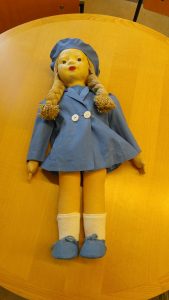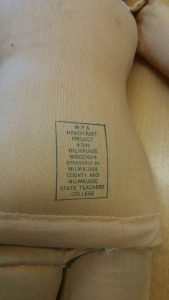Analyzing a Doll through the Montgomery Method
For my second-year thesis, I wrote about the Milwaukee Handicraft Project, a Work Project Administration program that operated in Wisconsin between 1935 and 1942. During the Great Depression, it hired 5,000 women in its eight-year run to make decorative arts objects for tax-supported institutions across the country. Among the many different goods that they made, I focused on their dolls. This department created and shipped tens of thousands of dolls per year, so the opportunities to analyze them were endless! One approach that I took was assessing how they were made. To do this research I applied the Montgomery method, a series of fourteen questions created by Charles Montgomery, first Director of the Winterthur Museum. The questions ask the viewer to consider material, ornament, and date of construction among many other aspects. It is a critical approach that can be applied to all kinds of objects!
For this blog post, I collapsed some of the categories into grouped questions. If you would like learn more about Montgomery’s fourteen-point connoisseurship method, please read his article entitled “The Connoisseurship of Artifacts.”

Blonde doll wearing a blue dress, “American Girl,” WPA Dolls, Jack Russell Memorial Library, Hartford, WI. Photograph by author. Courtesy of the Jack Russell Memorial Library.
First: what is your emotional reaction to this object? What jumps out at you first about her? What does she make you think of?
Second: what is her form? Do you think she looks realistic? What qualities about her makes her look human or artificial? I should add that she is actually quite large in person – 22 inches tall, the size of a toddler.
Third: how is she ornamented? What is her hairstyle? How is her face decorated? What do her clothes look like?
Fourth: materiality, which means what is she made of? Closely examine the texture of the fabric.
It can be difficult to tell with the photographs, but her face is made of balbriggan, an underwear material common in the early 20th century. The workers then filled her mold face with sawdust and poured sodium silicate into it to congeal the sawdust and to make her head sturdy. Her body is made of cotton percale and she is stuffed with kapok, a soft plant fiber.

Close-up of painted doll face attached to the doll body, “American Girl,” WPA Dolls, Jack Russell Memorial Library, Hartford, WI. Photograph by author. Courtesy of the Jack Russell Memorial Library.
Fifth is construction. How was she put together? What stitches did the makers use to unite the pieces of fabric? Is there evidence that some stitches were done by hand and other stitches with a sewing machine? What technique did the makers use to make her hair?
The sixth area of inquiry is function. What do you imagine she was used for? Who do you imagine played with the doll and how do you think they played with it? There are flaps of cloth attached to the top of each leg and the body. These allow the doll to sit up at a 90-degree angle with her legs in front of her. What impact do you imagine that this form had on how people played with her?

Close- up of stamp on the back of every 22-inch doll, “American Girl,” WPA Dolls, Jack Russell Memorial Library, Hartford, WI. Photograph by author. Courtesy of the Jack Russell Memorial Library.
Finally, we end here with attribution. Look closely at the stamp on her back. What does it tell us about the women working on the Milwaukee Handicraft Project, the makers of this doll? The program numbers included on the stamp serve as evidence of the year in which the doll was produced. The program number changed yearly and each number represents a new year of funding through the Work Projects Administration. The clothing, meanwhile, also has this stamp along with a second one that reads, “Designed by Helen Clarke,” the woman hired to design the doll’s clothing. These are both clues that point to the authenticity of the dolls.
I hope this has been a helpful introduction to the connoisseurship techniques of Charles F. Montgomery and the limitless objects that it can be applied to in our own lives!
By Allison Robinson, WPAMC Class of 2018

Leave a Reply